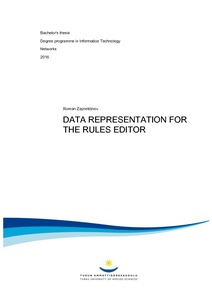Data representation for the rules editor
Zaynetdinov, Roman (2016)
Julkaisun pysyvä osoite on
https://urn.fi/URN:NBN:fi:amk-201603113095
https://urn.fi/URN:NBN:fi:amk-201603113095
Tiivistelmä
One way to have a reliable and solid software is to have a suitable data model. A well-chosen model helps to eliminate multiple issues from understanding the data to using the model properly in the software. As a result, such a model can lead to a simpler software implementation. When the software component is dependent on the data model, it is advisable to create a data model prior to starting the software implementation.
This thesis deals with creating a data model for the rules editor which will be included into the existing software of the company which commissioned this thesis. The data model should be reliable and transferred between the server side and the client side (client browser).
The thesis is structured as follows. Firstly, it describes the new software component to be built and its background. Secondly, it discusses t the limitation(restrictions) of the current system of the commissioning company. Then, it concludes with the most suitable data model which suits the current stack well without introducing new complexities and complicated changes to the company’s system. Finally, it discusses alternative methods of solving the problem and evaluates if the problem has been solved correctly.
This thesis deals with creating a data model for the rules editor which will be included into the existing software of the company which commissioned this thesis. The data model should be reliable and transferred between the server side and the client side (client browser).
The thesis is structured as follows. Firstly, it describes the new software component to be built and its background. Secondly, it discusses t the limitation(restrictions) of the current system of the commissioning company. Then, it concludes with the most suitable data model which suits the current stack well without introducing new complexities and complicated changes to the company’s system. Finally, it discusses alternative methods of solving the problem and evaluates if the problem has been solved correctly.

